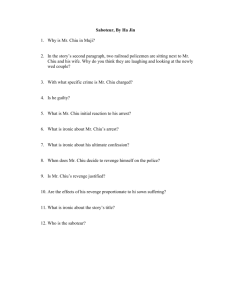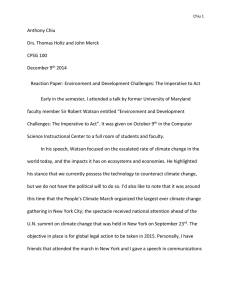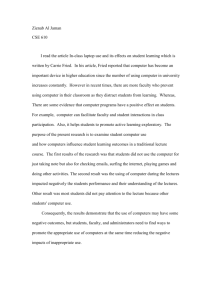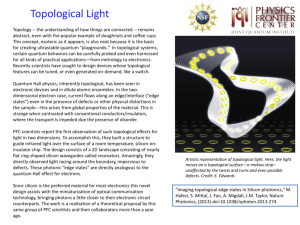Topological Structure of the QCD Vacuum Ting-Wai Chiu
advertisement
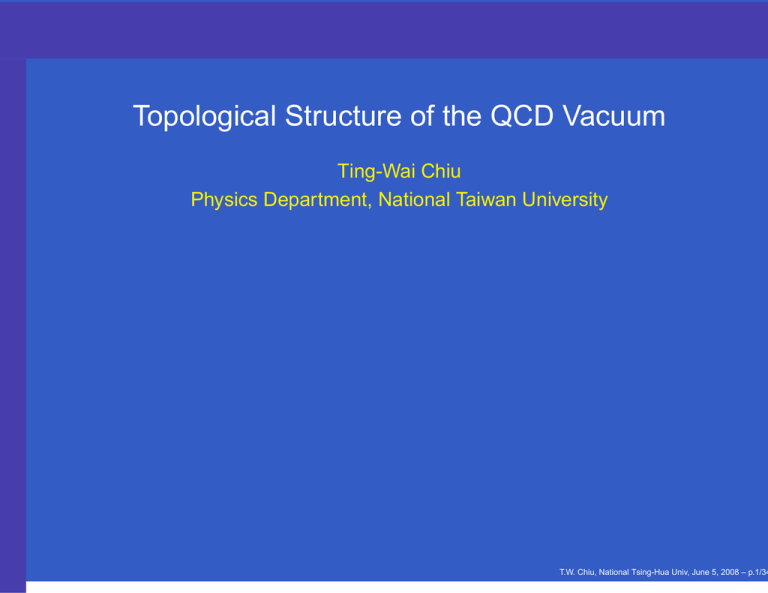
Topological Structure of the QCD Vacuum Ting-Wai Chiu Physics Department, National Taiwan University T.W. Chiu, National Tsing-Hua Univ, June 5, 2008 – p.1/34 The vacuum of QCD has a non-trivial topological structure. T.W. Chiu, National Tsing-Hua Univ, June 5, 2008 – p.2/34 The vacuum of QCD has a non-trivial topological structure. The cluster property and the gauge invariance require that the ground state must be the θ vacuum, a superposition of gauge configurations in different topological sectors. T.W. Chiu, National Tsing-Hua Univ, June 5, 2008 – p.2/34 The vacuum of QCD has a non-trivial topological structure. The cluster property and the gauge invariance require that the ground state must be the θ vacuum, a superposition of gauge configurations in different topological sectors. The topological structure is also essential for the resolution of the U (1) problem, i.e., the flavor singlet pseudo-scalar meson knows the presence of non-trivial topological charge in the QCD vacuum. T.W. Chiu, National Tsing-Hua Univ, June 5, 2008 – p.2/34 The vacuum of QCD has a non-trivial topological structure. The cluster property and the gauge invariance require that the ground state must be the θ vacuum, a superposition of gauge configurations in different topological sectors. The topological structure is also essential for the resolution of the U (1) problem, i.e., the flavor singlet pseudo-scalar meson knows the presence of non-trivial topological charge in the QCD vacuum. Therefore, the topological excitations, such as the instantons, plays a central role in understanding the vacuum of QCD. T.W. Chiu, National Tsing-Hua Univ, June 5, 2008 – p.2/34 The vacuum of QCD has a non-trivial topological structure. The cluster property and the gauge invariance require that the ground state must be the θ vacuum, a superposition of gauge configurations in different topological sectors. The topological structure is also essential for the resolution of the U (1) problem, i.e., the flavor singlet pseudo-scalar meson knows the presence of non-trivial topological charge in the QCD vacuum. Therefore, the topological excitations, such as the instantons, plays a central role in understanding the vacuum of QCD. Since the topological excitations do not occur in the perturbation theory, theoretical calculations starting from the QCD Lagrangian necessarily involves non-perturbative methods, such as lattice QCD. T.W. Chiu, National Tsing-Hua Univ, June 5, 2008 – p.2/34 The main difficulties in lattice QCD are: (i) Definition of the topological charge density using the gauge links causes bad ultraviolet divergences. (the cooling methods devised to tame the short distance fluctuations introduce sizable systematic uncertainties.) T.W. Chiu, National Tsing-Hua Univ, June 5, 2008 – p.3/34 The main difficulties in lattice QCD are: (i) Definition of the topological charge density using the gauge links causes bad ultraviolet divergences. (the cooling methods devised to tame the short distance fluctuations introduce sizable systematic uncertainties.) (ii) Unquenched simulations with Wilson/staggered fermion do not respect correct chiral or flavor symmetry at finite lattice spacing, and the definition of the topological charge through the Atiyah-Singer index theorem is ambiguous. T.W. Chiu, National Tsing-Hua Univ, June 5, 2008 – p.3/34 The main difficulties in lattice QCD are: (i) Definition of the topological charge density using the gauge links causes bad ultraviolet divergences. (the cooling methods devised to tame the short distance fluctuations introduce sizable systematic uncertainties.) (ii) Unquenched simulations with Wilson/staggered fermion do not respect correct chiral or flavor symmetry at finite lattice spacing, and the definition of the topological charge through the Atiyah-Singer index theorem is ambiguous. (iii) With the HMC algorithm which is based on a continuous evolution of the gauge links, the system is trapped in a fixed topological sector as the continuum limit is approached. Therefore, a proper sampling of different topological sectors cannot be achieved. (Approaching the chiral limit, the suppression of the fermion determinant for Q 6= 0 also makes the tunneling a rare event.) T.W. Chiu, National Tsing-Hua Univ, June 5, 2008 – p.3/34 During the last decade, (i) and (ii) have been solved by the realization of exact chiral symmetry on the lattice, with which the topological charge is uniquely defined at any finite lattice spacing by counting the number of fermionic zero-modes. T.W. Chiu, National Tsing-Hua Univ, June 5, 2008 – p.4/34 During the last decade, (i) and (ii) have been solved by the realization of exact chiral symmetry on the lattice, with which the topological charge is uniquely defined at any finite lattice spacing by counting the number of fermionic zero-modes. However, (iii) remains insurmountable, since the correct sampling of topology becomes increasingly more difficult towards realistic simulation with lighter quarks and finer lattices. T.W. Chiu, National Tsing-Hua Univ, June 5, 2008 – p.4/34 During the last decade, (i) and (ii) have been solved by the realization of exact chiral symmetry on the lattice, with which the topological charge is uniquely defined at any finite lattice spacing by counting the number of fermionic zero-modes. However, (iii) remains insurmountable, since the correct sampling of topology becomes increasingly more difficult towards realistic simulation with lighter quarks and finer lattices. A plausible solution is to perform QCD simulations in a fixed topological sector and to extract topological susceptibility from local topological fluctuations. Then any observable measured at a fixed topological charge can be transcribed to its value in the θ vacuum. T.W. Chiu, National Tsing-Hua Univ, June 5, 2008 – p.4/34 Topology Susceptibility in 2-flavor QCD with Exact Chiral Symmetry (JLQCD-TWQCD, arXiv:0710.1130) The topological charge density is unambiguously defined on the lattice using the overlap-Dirac operator which possesses exact chiral symmetry. T.W. Chiu, National Tsing-Hua Univ, June 5, 2008 – p.5/34 Topology Susceptibility in 2-flavor QCD with Exact Chiral Symmetry (JLQCD-TWQCD, arXiv:0710.1130) The topological charge density is unambiguously defined on the lattice using the overlap-Dirac operator which possesses exact chiral symmetry. Simulations are performed on a 163 × 32 lattice at lattice spacing ∼ 0.12 fm at six sea quark masses mq ranging in ms /6–ms . T.W. Chiu, National Tsing-Hua Univ, June 5, 2008 – p.5/34 Topology Susceptibility in 2-flavor QCD with Exact Chiral Symmetry (JLQCD-TWQCD, arXiv:0710.1130) The topological charge density is unambiguously defined on the lattice using the overlap-Dirac operator which possesses exact chiral symmetry. Simulations are performed on a 163 × 32 lattice at lattice spacing ∼ 0.12 fm at six sea quark masses mq ranging in ms /6–ms . The χt (topological susceptibility) is extracted from the constant behavior of the time-correlation of flavor-singlet pseudo-scalar meson two-point function at large distances, which arises from the finite size effect due to the fixed topology. T.W. Chiu, National Tsing-Hua Univ, June 5, 2008 – p.5/34 Topology Susceptibility in 2-flavor QCD with Exact Chiral Symmetry (JLQCD-TWQCD, arXiv:0710.1130) The topological charge density is unambiguously defined on the lattice using the overlap-Dirac operator which possesses exact chiral symmetry. Simulations are performed on a 163 × 32 lattice at lattice spacing ∼ 0.12 fm at six sea quark masses mq ranging in ms /6–ms . The χt (topological susceptibility) is extracted from the constant behavior of the time-correlation of flavor-singlet pseudo-scalar meson two-point function at large distances, which arises from the finite size effect due to the fixed topology. In the small mq regime, our result of χt is proportional to mq as expected from chiral effective theory. Using the formula χt = mq Σ/Nf by Leutwyler-Smilga, we obtain ΣMS (2 GeV) = [252(5)(10)MeV]3 T.W. Chiu, National Tsing-Hua Univ, June 5, 2008 – p.5/34 Outline Introduction Topology with Overlap Dirac Operator Lattice Setup Results using Nf = 2 Dynamical Overlap Configurations with Qt = 0, −2, −4 Conclusion and Outlook T.W. Chiu, National Tsing-Hua Univ, June 5, 2008 – p.6/34 Introduction Theoretically, topological susceptibility is defined as Z χt = d4 x hρ(x)ρ(0)i where 1 ρ(x) = µνλσ tr[Fµν (x)Fλσ (x)] 2 32π T.W. Chiu, National Tsing-Hua Univ, June 5, 2008 – p.7/34 Introduction Theoretically, topological susceptibility is defined as Z χt = d4 x hρ(x)ρ(0)i where 1 ρ(x) = µνλσ tr[Fµν (x)Fλσ (x)] 2 32π Veneziano-Witten relation fπ2 m2η0 χt (quenched) = 4Nf T.W. Chiu, National Tsing-Hua Univ, June 5, 2008 – p.7/34 Introduction Theoretically, topological susceptibility is defined as Z χt = d4 x hρ(x)ρ(0)i where 1 ρ(x) = µνλσ tr[Fµν (x)Fλσ (x)] 2 32π Veneziano-Witten relation fπ2 m2η0 χt (quenched) = 4Nf Leutwyler-Smilga relation mq Σ + O(m2q ) (in the chiral limit) χt = Nf T.W. Chiu, National Tsing-Hua Univ, June 5, 2008 – p.7/34 Introduction (cont) For lattice QCD with fixed topology in a finite volume, χt is the most crucial quantity which is used to relate any observable measured in the fixed topology to its physical value. Brower, Chandrasekaran, Negele, Wiese, PLB 560 (2003) 64 Aoki, Fukaya, Hashimoto, Onogi, PRD 76 (2007) 054508 T.W. Chiu, National Tsing-Hua Univ, June 5, 2008 – p.8/34 Introduction (cont) For lattice QCD with fixed topology in a finite volume, χt is the most crucial quantity which is used to relate any observable measured in the fixed topology to its physical value. Brower, Chandrasekaran, Negele, Wiese, PLB 560 (2003) 64 Aoki, Fukaya, Hashimoto, Onogi, PRD 76 (2007) 054508 In other words, the artifacts due to fixed topology can be removed, provided that χt has been determined. T.W. Chiu, National Tsing-Hua Univ, June 5, 2008 – p.8/34 Introduction (cont) Since χt = Z 1 2 Qt , Ω = volume d x hρ(x)ρ(0)i = Ω Z 1 µνλσ tr[Fµν (x)Fλσ (x)] = integer dx 2 32π 4 where Qt = 4 one can obtain χt by counting the number of gauge configurations for each topological sector. T.W. Chiu, National Tsing-Hua Univ, June 5, 2008 – p.9/34 Introduction (cont) Since χt = Z 1 2 Qt , Ω = volume d x hρ(x)ρ(0)i = Ω Z 1 µνλσ tr[Fµν (x)Fλσ (x)] = integer dx 2 32π 4 where Qt = 4 one can obtain χt by counting the number of gauge configurations for each topological sector. However, for a set of gauge configurations in the topologically-trivial sector, Qt = 0, it gives χt = 0 T.W. Chiu, National Tsing-Hua Univ, June 5, 2008 – p.9/34 Introduction (cont) Even for a topologically-trivial gauge configuration, it may possess near-zero modes due to excitation of instanton and anti-instanton pairs, which are the origin of spontaneous chiral symmetry breaking in the infinite volume limit. T.W. Chiu, National Tsing-Hua Univ, June 5, 2008 – p.10/34 Introduction (cont) Even for a topologically-trivial gauge configuration, it may possess near-zero modes due to excitation of instanton and anti-instanton pairs, which are the origin of spontaneous chiral symmetry breaking in the infinite volume limit. Thus, one can investigate whether there are topological excitations within any sub-volumes, and to measure the topological susceptibility using the correlation of the topological charges of two sub-volumes. T.W. Chiu, National Tsing-Hua Univ, June 5, 2008 – p.10/34 Introduction (cont) For any topological sector with Qt , using χPT, it can be shown that 2 c4 1 Qt − χt − + O(Ω−3 ) lim hρ(x)ρ(y)i = Ω Ω 2χt Ω |x−y|→∞ Aoki, Fukaya, Hashimoto, Onogi, PRD 76 (2007) 054508 T.W. Chiu, National Tsing-Hua Univ, June 5, 2008 – p.11/34 Introduction (cont) For any topological sector with Qt , using χPT, it can be shown that 2 c4 1 Qt − χt − + O(Ω−3 ) lim hρ(x)ρ(y)i = Ω Ω 2χt Ω |x−y|→∞ Aoki, Fukaya, Hashimoto, Onogi, PRD 76 (2007) 054508 Thus, in the trivial sector with Qt = 0, for any two widely separated sub-volumes Ω1 and Ω2 , the correlation of their topological charges would behave as Z c4 Ω1 Ω2 d4 x ρ(x) χt + Qi = hQ1 Q2 i ' − Ω 2χt Ω Ωi T.W. Chiu, National Tsing-Hua Univ, June 5, 2008 – p.11/34 Introduction (cont) On a finite lattice, consider two spatial sub-volumes at time slices t1 and t2 , measure the time-correlation function C(t1 − t2 ) = hQ(t1 )Q(t2 )i = X hρ(x1 )ρ(x2 )i x~1 ,x~2 T.W. Chiu, National Tsing-Hua Univ, June 5, 2008 – p.12/34 Introduction (cont) On a finite lattice, consider two spatial sub-volumes at time slices t1 and t2 , measure the time-correlation function C(t1 − t2 ) = hQ(t1 )Q(t2 )i = X hρ(x1 )ρ(x2 )i x~1 ,x~2 Then its plateau at large |t1 − t2 | can be used to extract χt , provided that |c4 | 2χ2t Ω, 1 4 2 2 c4 = − hQt iθ=0 − 3hQt iθ=0 Ω T.W. Chiu, National Tsing-Hua Univ, June 5, 2008 – p.12/34 Introduction (cont) On a finite lattice, consider two spatial sub-volumes at time slices t1 and t2 , measure the time-correlation function C(t1 − t2 ) = hQ(t1 )Q(t2 )i = X hρ(x1 )ρ(x2 )i x~1 ,x~2 Then its plateau at large |t1 − t2 | can be used to extract χt , provided that |c4 | 2χ2t Ω, 1 4 2 2 c4 = − hQt iθ=0 − 3hQt iθ=0 Ω However, on a lattice, it is difficult to extract ρ(x) unambiguously from the link variables ! T.W. Chiu, National Tsing-Hua Univ, June 5, 2008 – p.12/34 Topology with Overlap Dirac Operator It is well known that the topological charge density can be defined via the overlap Dirac operator as 1 ρ(x) = tr[γ5 (1 − rD)x,x ], r = 2m0 where D is the overlap Dirac operator Hw D = m0 (1 + V ), V = γ5 p , Hw2 Hw = γ5 (−m0 + γµ tµ + W ) T.W. Chiu, National Tsing-Hua Univ, June 5, 2008 – p.13/34 Topology with Overlap Dirac Operator (cont) Here ρ(x) = tr[γ5 (1 − rD)x,x ] is justified to be a definition of topological charge density since it has been asserted (Kikukawa & Yamada, 1998) 1 µνλσ tr[Fµν (x)Fλσ (x)] ρ(x) −→ 2 32π a→0 T.W. Chiu, National Tsing-Hua Univ, June 5, 2008 – p.14/34 Topology with Overlap Dirac Operator (cont) Here ρ(x) = tr[γ5 (1 − rD)x,x ] is justified to be a definition of topological charge density since it has been asserted (Kikukawa & Yamada, 1998) 1 µνλσ tr[Fµν (x)Fλσ (x)] ρ(x) −→ 2 32π a→0 Note that the index theorem on the lattice X index(D) = n+ − n− = ρ(x) = Qt x had been observed by Narayanan and Neuberger in 1995, using the spectral flow of Hw (m0 ), before the Ginsparg-Wilson relation was rejuvenated in 1998. T.W. Chiu, National Tsing-Hua Univ, June 5, 2008 – p.14/34 Topology with Overlap Dirac Operator (cont) It seems natural to use ρ(x) = tr[γ5 (1 − rD)x,x ] to compute the topological susceptibility X 1X 1 2 hρ(x)ρ(y)i = hρ(x)ρ(0)i χt = hQt i = Ω Ω x,y x T.W. Chiu, National Tsing-Hua Univ, June 5, 2008 – p.15/34 Topology with Overlap Dirac Operator (cont) It seems natural to use ρ(x) = tr[γ5 (1 − rD)x,x ] to compute the topological susceptibility X 1X 1 2 hρ(x)ρ(y)i = hρ(x)ρ(0)i χt = hQt i = Ω Ω x,y x On the other hand, one can derive the relation X −1 ] = m Tr[γ (D + m) ] index(D) = m tr[γ5 (Dc + m)−1 5 c x,x x where Dc = D(1 − rD)−1 = 2m0 (1 + V )(1 − V )−1 is chirally symmetric but non-local (Chiu & Zenkin, 1998). Note that for the topologically-trivial configurations , Dc is well-defined (without any poles). T.W. Chiu, National Tsing-Hua Univ, June 5, 2008 – p.15/34 Topology with Overlap Dirac Operator (cont) Thus one can regard ρ1 (x) = m tr[γ5 (Dc + m)−1 x,x ] as a definition of topological charge density, for any valence quark mass m. T.W. Chiu, National Tsing-Hua Univ, June 5, 2008 – p.16/34 Topology with Overlap Dirac Operator (cont) Thus one can regard ρ1 (x) = m tr[γ5 (Dc + m)−1 x,x ] as a definition of topological charge density, for any valence quark mass m. Obviously, the identity index(D) = m Tr[γ5 (Dc + m)−1 ] can be generalized to index(D) = m1 m2 · · · mk Tr[γ5 (Dc + m1 )−1 (Dc + m2 )−1 · · · (Dc + mk )−1 ] with the generalized topological charge density ρk (x) = m1 m2 · · · mk tr[γ5 (Dc + m1 )−1 (Dc + m2 )−1 · · · (Dc + mk )−1 ]x,x T.W. Chiu, National Tsing-Hua Univ, June 5, 2008 – p.16/34 Topology with Overlap Dirac Operator (cont) Presumably, any ρk can be used to compute χt . In general, m1 · · · mk mk+1 · · · ml hTr[γ5 (Dc + m1 )−1 · · · (Dc + mk )−1 ] × χt = Ω Tr[γ5 (Dc + mk+1 )−1 · · · (Dc + ml )−1 ]i T.W. Chiu, National Tsing-Hua Univ, June 5, 2008 – p.17/34 Topology with Overlap Dirac Operator (cont) Presumably, any ρk can be used to compute χt . In general, m1 · · · mk mk+1 · · · ml hTr[γ5 (Dc + m1 )−1 · · · (Dc + mk )−1 ] × χt = Ω Tr[γ5 (Dc + mk+1 )−1 · · · (Dc + ml )−1 ]i It has been pointed out by Lüscher, for k ≥ 2 and l ≥ 5, χt avoids the short-distance singularities in the continuum limit. T.W. Chiu, National Tsing-Hua Univ, June 5, 2008 – p.17/34 Topology with Overlap Dirac Operator (cont) However, on a finite lattice, 1 lim hρ1 (x)ρ1 (y)i ' |x−y|1 Ω Q2t c4 − χt − Ω 2χt Ω + O(e−mπ |x−y| ) +O(e−mη0 |x−y| ) + O(Ω−3 ) + · · · is contaminated by mπ , mη0 , · · · , which can couple to hρ1 (x)ρ1 (y)i. T.W. Chiu, National Tsing-Hua Univ, June 5, 2008 – p.18/34 Topology with Overlap Dirac Operator (cont) However, on a finite lattice, 1 lim hρ1 (x)ρ1 (y)i ' |x−y|1 Ω Q2t c4 − χt − Ω 2χt Ω + O(e−mπ |x−y| ) +O(e−mη0 |x−y| ) + O(Ω−3 ) + · · · is contaminated by mπ , mη0 , · · · , which can couple to hρ1 (x)ρ1 (y)i. A better alternative is to compute the correlator of flavor-singlet η 0 , which behaves as 2 c4 1 Qt 2 0 0 − χt − + O(e−mη0 |x−y| ) lim mq hη (x)η (y)i ' |x−y|1 Ω Ω 2χt Ω +O(Ω−3 ) + · · · Aoki, Fukaya, Hashimoto, Onogi, PRD 76 (2007) 054508 T.W. Chiu, National Tsing-Hua Univ, June 5, 2008 – p.18/34 Time-Correlation Function of η' Nf X Σ X 0 x 0 x −Σ 1 x Cη'(t) = x T.W. Chiu, National Tsing-Hua Univ, June 5, 2008 – p.19/34 Lattice Setup Lattice size: 163 × 32 Gluons: Iwasaki gauge action at β = 2.30 Quarks (Nf = 2): overlap Dirac operator with m0 = 1.6 Add extra Wilson fermions and pseudofermions 2 ) det(Hov −→ 2 ) det(Hov det(Hw2 ) , µ = 0.2 2 2 det(Hw + µ ) to forbid λ(Hw ) crossing zero, thus Qt is invariant. Quark masses: msea = 0.015, 0.025, 0.035, 0.050, 0.070, 0.100, each of 500 confs with Qt = 0. For msea = 0.05, 250 confs with Qt = −2, −4 respectively. For each configuration, 50 conjugate pairs of low-lying eigenmodes of overlap Dirac operator are projected. T.W. Chiu, National Tsing-Hua Univ, June 5, 2008 – p.20/34 0.010 3 16 x32, β=2.30, msea=mval=0.025 no. of confs = 520 0.008 disconnected (hairpin) 0.006 C(t) 0.004 0.002 0.000 -0.002 -0.004 5 10 15 20 25 t T.W. Chiu, National Tsing-Hua Univ, June 5, 2008 – p.21/34 0.010 3 16 x32, β=2.30, msea=mval=0.025 no. of confs = 520 0.008 disconnected (hairpin) connected 0.006 C(t) 0.004 0.002 0.000 -0.002 -0.004 5 10 15 20 25 t T.W. Chiu, National Tsing-Hua Univ, June 5, 2008 – p.22/34 0.010 3 16 x32, β=2.30, msea=mval=0.025 no. of confs = 520 0.008 disconnected (hairpin) connected −η' = hairpin - connected / Nf 0.006 C(t) 0.004 0.002 0.000 -0.002 -0.004 5 10 15 20 25 t T.W. Chiu, National Tsing-Hua Univ, June 5, 2008 – p.23/34 0.010 3 16 x32, β=2.30, msea=mval=0.025 no. of confs = 520 0.008 disconnected (hairpin) connected −η' = hairpin - connected / Nf 0.006 cosh + cη' C(t) 0.004 0.002 0.000 -0.002 -0.004 5 10 15 20 25 t T.W. Chiu, National Tsing-Hua Univ, June 5, 2008 – p.24/34 0.010 3 16 x32, β=2.30, msea=mval=0.025 no. of confs = 520 0.008 disconnected (hairpin) connected −η' = hairpin - connected / Nf 0.006 cosh + cη' 0.004 C(t) cη' 0.002 0.000 -0.002 -0.004 5 10 15 20 25 t T.W. Chiu, National Tsing-Hua Univ, June 5, 2008 – p.25/34 Saturation of η 0 by low-lying eigenmodes 0.0 3 16 x32, β=2.30, msea=mval=0.025 no. of configurations = 520 -1.0e-3 −Cη'(t) -2.0e-3 nev = 10 + 10 -3.0e-3 -4.0e-3 -5.0e-3 0 5 10 15 20 25 30 t T.W. Chiu, National Tsing-Hua Univ, June 5, 2008 – p.26/34 Saturation of η 0 by low-lying eigenmodes 0.0 3 16 x32, β=2.30, msea=mval=0.025 no. of configurations = 520 -1.0e-3 −Cη'(t) -2.0e-3 nev = 10 + 10 nev = 20 + 20 -3.0e-3 -4.0e-3 -5.0e-3 0 5 10 15 20 25 30 t T.W. Chiu, National Tsing-Hua Univ, June 5, 2008 – p.27/34 Saturation of η 0 by low-lying eigenmodes 0.0 3 16 x32, β=2.30, msea=mval=0.025 no. of configurations = 520 -1.0e-3 −Cη'(t) -2.0e-3 nev = 10 + 10 nev = 20 + 20 nev = 30 + 30 -3.0e-3 -4.0e-3 -5.0e-3 0 5 10 15 20 25 30 t T.W. Chiu, National Tsing-Hua Univ, June 5, 2008 – p.28/34 Saturation of η 0 by low-lying eigenmodes 0.0 3 16 x32, β=2.30, msea=mval=0.025 no. of configurations = 520 -1.0e-3 −Cη'(t) -2.0e-3 nev nev nev nev -3.0e-3 = = = = 10 20 30 40 + + + + 10 20 30 40 -4.0e-3 -5.0e-3 0 5 10 15 20 25 30 t T.W. Chiu, National Tsing-Hua Univ, June 5, 2008 – p.29/34 Saturation of η 0 by low-lying eigenmodes 0.0 3 16 x32, β=2.30, msea=mval=0.025 no. of configurations = 520 -1.0e-3 −Cη'(t) -2.0e-3 nev nev nev nev nev -3.0e-3 = = = = = 10 20 30 40 50 + + + + + 10 20 30 40 50 -4.0e-3 -5.0e-3 0 5 10 15 20 25 30 t T.W. Chiu, National Tsing-Hua Univ, June 5, 2008 – p.30/34 Realization of Leutwyler-Smilga relation 2.0e-4 _ ChPT χt = mΣ/nf ΣMS(2 GeV) = [252(5)(6) MeV]3 1.5e-4 a4χt 1.0e-4 5.0e-5 0.0 0.00 0.02 0.04 0.06 0.08 0.10 mq In the limit m → 0, χt → mΣ/Nf , in agreement with ChPT. T.W. Chiu, National Tsing-Hua Univ, June 5, 2008 – p.31/34 Determination of Σ From the slope of the linear fit of χt vs. mq for mq a = 0.015, 0.025, and 0.035, it gives a3 Σ = 0.00257(10) With a−1 = 1670(20)(20) MeV, and MS (2 GeV) = 0.742(12), the value of a3 Σ is transcribed to Zm ΣMS (2 GeV) = (252 ± 5 ± 10 MeV)3 in good agreement with our previous result 251(7)(11) MeV obtained in the -regime. H. Fukaya et al. (JLQCD-TWQCD) PRL 98 (2007) 172001; PRD 76 (2007) 054503 T.W. Chiu, National Tsing-Hua Univ, June 5, 2008 – p.32/34 Universality of χt for different Topological Sectors 3.0e-4 3 16 x32, β=2.30, msea=mval=0.050 Qt = 0, 500 confs. Qt =-2, 250 confs. Qt =-4, 250 confs. 2.0e-4 a4χt 1.0e-4 0.0 -5 -4 -3 -2 -1 0 1 Qtop T.W. Chiu, National Tsing-Hua Univ, June 5, 2008 – p.33/34 Conclusion and Outlook For the topologically-trivial gauge configurations generated with Nf = 2 dynamical overlap quarks constrainted by extra Wilson and pseudofermions, they possess topologically non-trivial excitations (e.g., instanton and anti-instanton pairs) in sub-volumes. T.W. Chiu, National Tsing-Hua Univ, June 5, 2008 – p.34/34 Conclusion and Outlook For the topologically-trivial gauge configurations generated with Nf = 2 dynamical overlap quarks constrainted by extra Wilson and pseudofermions, they possess topologically non-trivial excitations (e.g., instanton and anti-instanton pairs) in sub-volumes. These near-zero modes allow us to determine χt and Σ. T.W. Chiu, National Tsing-Hua Univ, June 5, 2008 – p.34/34 Conclusion and Outlook For the topologically-trivial gauge configurations generated with Nf = 2 dynamical overlap quarks constrainted by extra Wilson and pseudofermions, they possess topologically non-trivial excitations (e.g., instanton and anti-instanton pairs) in sub-volumes. These near-zero modes allow us to determine χt and Σ. In the chiral limit, χt = mΣ/Nf is realized, with ΣM S (2 GeV) = 252(5)(10) MeV, in good agreement with our result in -regime. T.W. Chiu, National Tsing-Hua Univ, June 5, 2008 – p.34/34 Conclusion and Outlook For the topologically-trivial gauge configurations generated with Nf = 2 dynamical overlap quarks constrainted by extra Wilson and pseudofermions, they possess topologically non-trivial excitations (e.g., instanton and anti-instanton pairs) in sub-volumes. These near-zero modes allow us to determine χt and Σ. In the chiral limit, χt = mΣ/Nf is realized, with ΣM S (2 GeV) = 252(5)(10) MeV, in good agreement with our result in -regime. For msea = 0.05, χt extracted from different topological sectors (Qt = 0, −2, −4) are consistent with each other. T.W. Chiu, National Tsing-Hua Univ, June 5, 2008 – p.34/34 Conclusion and Outlook For the topologically-trivial gauge configurations generated with Nf = 2 dynamical overlap quarks constrainted by extra Wilson and pseudofermions, they possess topologically non-trivial excitations (e.g., instanton and anti-instanton pairs) in sub-volumes. These near-zero modes allow us to determine χt and Σ. In the chiral limit, χt = mΣ/Nf is realized, with ΣM S (2 GeV) = 252(5)(10) MeV, in good agreement with our result in -regime. For msea = 0.05, χt extracted from different topological sectors (Qt = 0, −2, −4) are consistent with each other. It remains to obtain an upper bound of c4 (from 2-pt and 4-pt correl. fn.) to see whether |c4 | 2χ2t Ω is satisfied. T.W. Chiu, National Tsing-Hua Univ, June 5, 2008 – p.34/34
